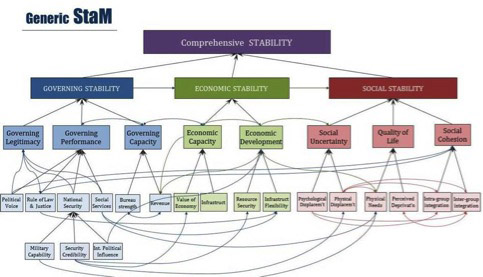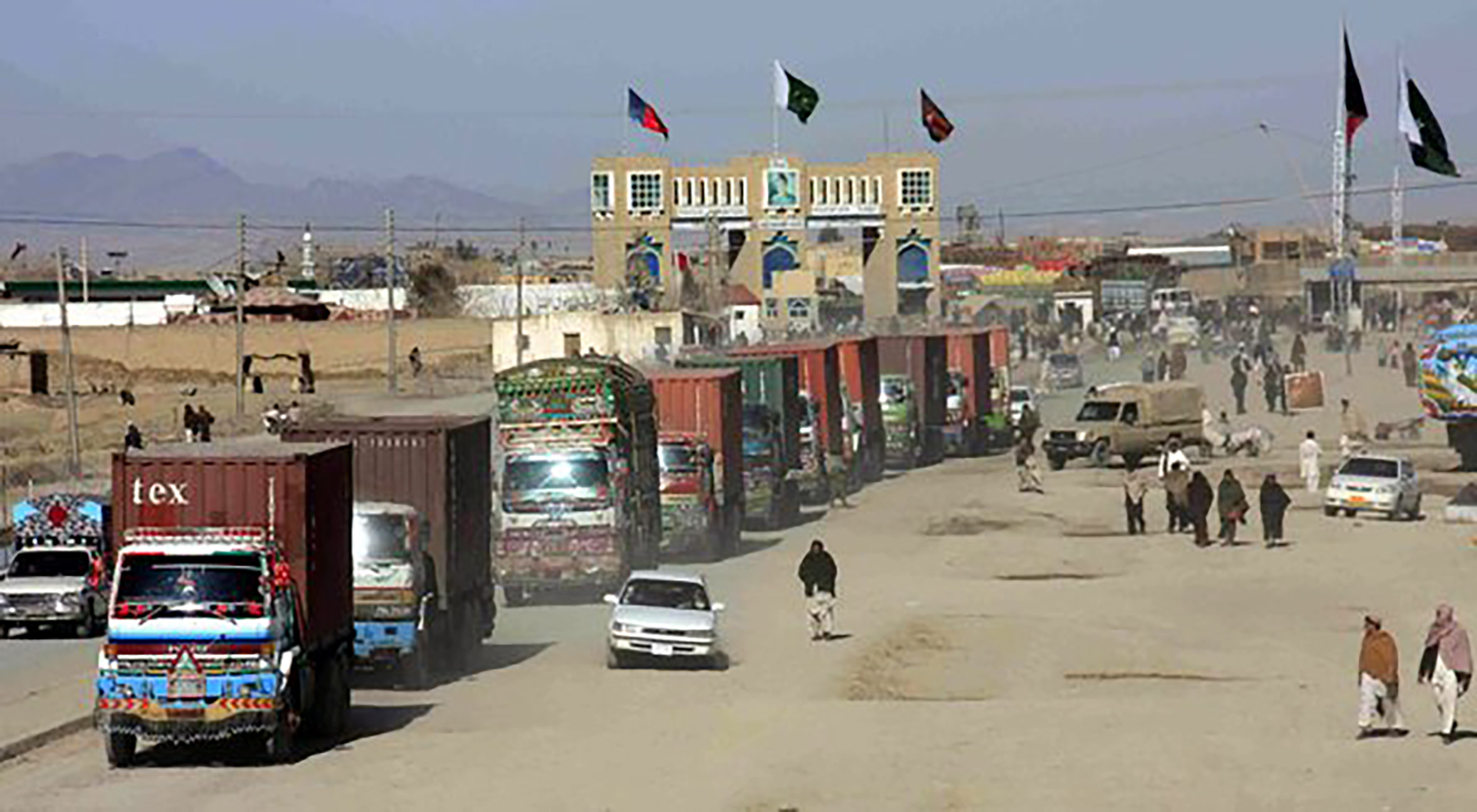STABILITY MODEL (StaM) ASSESSMENTS
NSI’s stability model (StaM) represents both a conceptual framework and an analytic methodology to guide users through a systematic process of obtaining a rich contextual understanding of an operating environment considering the full range of social, economic, and political conditions and factors. These are also informed and shaped by cultural values and principles, and historical experiences.

Stability Model (StaM) Background and Motivation
Over the past decade, the United States Government has recognized the importance of obtaining a rich contextual understanding of the operating environment, specifically focusing on the socio-cultural element, when addressing the current threats facing United States security interests, at home and abroad. This emphasis reflects a desire to obtain insight into the motivations underlying others’ intended or actual participation in violence against the United States, as well as the engagement strategies and initiatives that would be effective and sustainable within a given area of interest (AOI). However, this shift in thinking requires analysts and planners to quickly develop a nuanced, culturally informed understanding of the AOIs in which they are working in order to systematically assess their overall stability and identify areas of strength and weakness. A holistic understanding of the operating environment makes it possible to identify critical points in the system—both for stability and instability—and target engagement strategies and initiatives accordingly. This assessment also examines not only the first-order effects, but also potential second- and third-order effects, of US actions across multiple dimensions (governing, economic, and social).

StaM Overview
NSI’s stability model (StaM) represents our stability model analysis approach that is both a conceptual framework and an analytic methodology to guide users through a systematic process of obtaining a rich contextual understanding of the operating environment. A rich contextual understanding considers the full range of social, economic, and governing conditions and factors within a specific AOI and how these are informed and shaped by cultural values and principles as well as historical experiences. The StaM aids users not only in identifying the factors that explain the stability or instability of a nation-state, region, or other area of interest, but also in making the connections between and among the various stability factors apparent—allowing users to derive all implications of a potential engagement strategy. The StaM methodology involves an iterative process of “tailoring” or customizing the generic framework to a specific geographic or political area of interest. The output of a StaM effort includes identification of immediate and longer-term buffers to political, economic, and social stability and sources of population resilience, as well as immediate and longer-term drivers of instability and collapse. Once a tailored StaM has been prepared, it can be used to address further questions; these include questions regarding the impact of external actors or the most effective and stability-promoting means of engaging with the AOI. The generic StaM framework, shown in the Figure, consolidates political, economic, and social peer-reviewed quantitative and qualitative scholarship into a single stability model based on these three dimensions and, critically, specifies the relationships among them. As such, the StaM represents a cross-dimension summary, which draws on rich traditions of theory and research on stability and instability from diverse fields, including anthropology, political science and international relations, social psychology, sociology, and economics.
Analytic Uses of the StaM
The overall stability of an AOI—which can be defined within the StaM as either a nation-state, sub-state region, or city—is defined as a compound function of its political, economic, and social stability. Note that the StaM is agnostic to form of governance. Democratic governance is not presumed. It is also agnostic to the type of economic system and typically will include formal, grey (or informal), and black economic elements. Finally, within the StaM, neither overall stability nor social stability suggest violence- or unrest-free societies, but those where social structures are known and durable, and social cleavages and conflicts are for the most part manageable. Furthermore, stability does not imply a lack of change. Rather, it denotes the flexibility and resilience of a system to adapt to changes over time, without economic, social, or political consequences that threaten the viability of the system.
Identifying AOI-Specific Stability Conditions
A fully tailored StaM provides analysts and planners with a holistic picture of the governing, economic, and social conditions within a specific AOI and whether that AOI is moving toward or away from conditions consistent with stability in both the short and longer term. It also enables the identification of AOI-specific drivers of instability, buffers to stability, and the exogenous conditions that can intensify these effects. Tailoring a StaM requires systematically considering all of the central concepts, theory, and research pertaining to stability; and following the model process provides the planner or analyst with confidence that significant current or future sources of stability or instability have not been overlooked.
Monitoring and Early Warning
Once a tailored StaM has been created for an AOI, and the drivers, buffers, and intensifiers identified, the analyst or planner effectively understands what components of the model to pay attention to. This can significantly decrease the time and data requirements for monitoring an AOI over time. Furthermore, as the StaM also maps the crosscutting effects model components have on each other, we can monitor how changes in other components of the model may influence the condition of individual drivers and buffers. This increases the probability that changes with the potential to significantly increase or decrease stability will be identified early in their development.
Assessing the Second and Third Order Effects of Engagement Activities
One of the strengths of the StaM as an analytic tool is its ability to map the interrelationships between model components (crosscutting effects). This makes it possible for analysts and planners to trace the possible consequences of a proposed action and identify possible unintended consequences prior to undertaking an engagement activity. In effect, the model allows users to gain the “lessons learned” without having to make the mistakes that teach the lesson. More importantly, perhaps, the model enables planners and analysts to identify the location and causes of those negative effects. If identified in advance, it is possible that such obstacles can be avoided and unintended consequences minimized.
Maximizing the Effectiveness of Engagement Activities
The same crosscutting effects in the StaM that enable the identification of unintended consequences can also be used to determine how engagement activities can be structured and positioned to maximize their effect. By tracing the crosscutting effects from the component that is directly influenced by an engagement action, the planner or analyst can determine the system-wide implications of a specifically targeted action. By comparing different points or methods of influence, the relative impact of various COAs can be compared. In effect, you can determine where you get the most “bang for your buck”.
Improving Coordination Across USG Agencies and International Partners
In many cases, more than one USG agency may be operating in an AOI; this creates opportunities for coordination but also risks of duplication or even counteraction of effort. By assessing the second and third order effects of all USG efforts in a particular AOI, the planner or analyst can identify the areas where coordination of effort is most critical. Such an assessment can also bring to light opportunities where interagency collaboration would allow individual agencies to achieve mission objectives in areas that they cannot influence effectively working alone. This also holds for working with international partners.
Assessing the Implications of External Actor Actions
It can often be the case that the US is operating in an AOI in which other external actors—either states or non-state actors—are present. The actions of these external actors have potential to impact the stability of the AOI. The StaM allows analysts and planners to map the effects of specific external actor actions (e.g., presence of VEOs or large-scale economic investment by a foreign power) on the stability of the system as a whole. This in turn can provide a fuller picture of the possible implications of those actions for US interests broadly and ongoing or planned engagement activities more specifically.
Assessing the Second and Third Order Effects of Shocks to the System
An AOI-tailored StaM can also be used to assess the likely indirect effects of a particular system shock or crisis event (e.g., natural disaster, global financial crisis, major terrorist attack). The immediate effects of the shock (for example displacement of populations, crop destruction, and infrastructure damage after a natural disaster) can be located on the StaM and their second and third order effects mapped across the model. Identification of these effects prior to a shock occurring can improve planning and response.
StaM Applications
NSI has applied the StaM to Pakistan, Afghanistan, Nigeria, West Bank, and Dhaka, Bangladesh. We describe our StaM application to Pakistan (termed Pak-StaM) and Nigeria (termed Nigeria-StaM) here.

Pakistan StaM (Pak-StaM)
Pakistan sits at the center of South Asian regional security dynamics. Each of its several international borders has been both the cause of inter-state dispute and the site of militarized conflict. There are high levels of crime, violence, and sectarian conflict, and the writ of the state is challenged in many areas of the country. Porous borders facilitate organized crime, and militant activity further challenges state control and threatens the physical security and wellbeing of the Pakistani people. Investment (both government and private) in the weakly institutionalized, corrupt, and aid-dependent formal economy is insufficient to keep up with population growth, let alone enable Pakistan to reach its Millennium Development Goals. Finally, weak civilian governance, and a strongly politicized military blurs the lines of de jure authority. Yet, despite these significant problems and frequent predictions of imminent failure of the Pakistani state, Pakistan persists. Struggles over division of authority between the judiciary and elected leaders have weakened but not toppled the civilian government or triggered a military coup. While militants continue to challenge the writ of the state, they have not succeeded in fracturing Pakistan or establishing uncontested control. Discussion of the causes of Pakistan’s problems, and prescriptions for their cure are plentiful; however, there is less to be found on the factors that have enabled the Pakistani state and people to survive these challenges. Addressing the question of why Pakistan has not failed is equally important if we are to develop a complete picture of Pakistan’s current situation and future trajectory. This requires us to determine not only the factors that drive instability, but also those that buffer stability.
PaK-StaM is a conceptual model of state stability that systematically identified the drivers of instability as well as the buffer of stability (areas of resilience) in Pakistan. The PaK-StaM addressed a number of key questions regarding the factors that underpin stability and instability in Pakistan: Which are the factors that most significantly contribute to governing, economic, and social stability in Pakistan? Are there factors commonly associated with stability that have no effect or have divergent effects on stability in Pakistan? What are the primary effect dependencies among factors? Is the effect of specific factors likely to change with time? PaK-StaM illuminated several factors that appear to be pivotal to stability conditions in Pakistan. Each of these have short and longer-term implications of a critical domestic factor identified as driving stability conditions in Pakistan including: the grey economy, formal foreign remittances, patronage, weak civilian institutions, education, and access to information. The full Pak-StaM report has detailed chapter write ups for each of these six factors. Our analysis concluded that while there are evident drivers of instability, there are also less immediately evident areas of resilience that buffer the stability of the state of Pakistan and its people. Moreover, the factors that appear to underpin Pakistan’s resilience to collapse are closely linked to those that may promote instability in the longer term. That is, it appears that, for Pakistan, shorter-term stabilizers can easily become destabilizers in the longer term. Conversely, there are factors that disrupt to the status quo, and can appear destabilizing, but are in fact an essential part of generating the structural changes Pakistan needs to achieve long-term stability. Accounting for both the short-term and long-term effects of various drivers of stability is essential for understanding their full implications for stability.

Nigeria StaM (Nigeria-StaM)
In 2014, Nigeria overtook South Africa to become the largest African economy. The benefits of this economic success have not, however, translated into increased quality of life for the majority of Nigerians. Furthermore, Nigeria has factors often associated with high levels of instability, in particular a history of military rule, strong religious and ethnic identities, a lack of strong national identity, rapid urbanization, political and economic inequality between social groups, a disproportionately large youth population (“youth bulge”), widespread lack of access to basic services, and food insecurity. There is also dissatisfaction with how the government is handling extremist threats, and data from various public opinion polls indicates that security-related issues are perceived to be very important; however, concerns over unemployment and poor economic performance are even greater. While there is also overall dissatisfaction with government performance in the security area, this dissatisfaction with government performance is not translating to dissatisfaction with democracy more broadly. Numerous polls report that the percentage of Nigerians reporting that democracy is preferable to any other kind of government remains high, and the research suggested that the government policies in place currently are compatible with the traditional values of the major social groups. Low levels of military investment by the government has resulted in a Nigerian military that is currently underequipped and lacks the modern military hardware it needs to counter Boko Haram and other violent extremist organizations. While this limitation in defending Nigerians against internal threats is suffering and a driver of short-term instability in Nigeria, in the longer term, it may contribute to governing stability by decreasing the likelihood that the military will have the necessary capability and influence to stage a coup or the popular support necessary to maintain it.
One of the strengths of the StaM is that it is a comprehensive model of system stability, incorporating social, economic, and political (governing) dimensions. The initial output of a StaM analysis is the creation of an AOI-specific tailored StaM, in this case Nigeria-StaM. The tailored Nigeria-StaM is then used to conduct a variety of analyses of Nigerian drivers of instability, buffers to stability, and the exogenous conditions that can intensify these effects. The importance of this holistic approach is demonstrated by the Nigeria-StaM analysis of oil bunkering in Nigeria. At first glance, oil bunkering would appear to be an economic issue; however, a Nigeria-StaM analysis demonstrates that one of its primary drivers is rooted in a social stability phenomenon—perceived relative deprivation—and it has implications for all dimensions of stability. This immediately tells us that simple interdiction to the issue is unlikely to be an effective response, as the root cause (perceived deprivation) would remain, likely giving rise to other forms of compensatory action. Nigeria-StaM analysis exposes the fact that oil bunkering can have an immediate positive effect on quality of life for some (increasing social stability directly, and, through this, governing stability) by providing income to individuals and groups who have few economic opportunities. However, at the same time, the environmental damage has an immediate, negative effect on quality of life for others. When we consider both short-term and longer-term stability implications, similar confounding findings emerge. In the short term, those who participate in oil bunkering directly, and those who benefit indirectly through the additional money it generates for poor regions, see increases in their economic security, which can buffer social and even governing stability. However, this must be balanced against the damage to physical infrastructure, loss of government revenue, and potential loss of foreign investment that this practice creates, each of which can be shown by the loop diagram to have a host of additional concomitant first and nth order effects (e.g., on economic growth and development, value of the formal economy, and ultimately even quality of life—counteracting the positive impact on quality of life that follows more immediately from oil bunkering activity). Oil bunkering is a symptom of more systemic problems within Nigeria that have their roots in social and governing stability factors. Even if it were possible to stop or even limit the practice, the motivating factors behind oil bunkering activities (viz., perceived relative deprivation, corruption, dissatisfaction with distribution of oil revenues) would remain as drivers of instability for the country. In this way, oil bunkering exemplifies one of the primary challenges facing Nigerian government moving forward: how to demonstrate to a socially diverse population experiencing vastly different outcomes from Nigeria’s growth, that it is willing to and capable of translating that national level growth into measurable improvement in the lives of all Nigerians.